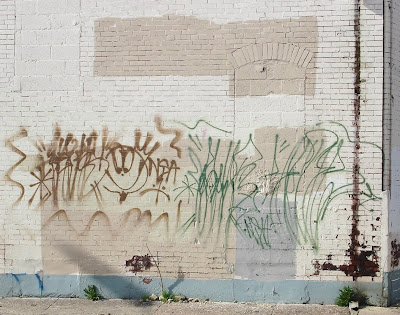 If you've been reading for a while you may know how I like to use photographs of the city as inspiration for my embroideries, more recently zeroing in on walls and graffiti. Tomorrow I'll be presenting to the Philadelphia Handweaver's guild on how media has been an influence on embroidery in America since colonial times to the present. So for a more contemporary snapshot, I'm curious:
If you've been reading for a while you may know how I like to use photographs of the city as inspiration for my embroideries, more recently zeroing in on walls and graffiti. Tomorrow I'll be presenting to the Philadelphia Handweaver's guild on how media has been an influence on embroidery in America since colonial times to the present. So for a more contemporary snapshot, I'm curious:Are you or How are you influenced by images/text found in print media today?


I think we see so much great imagery and typography it's hard not to be influenced by print media. But one example. Right now I'm studying tattoo designs I might interpret through embroidery, mostly because of some really beautiful tattoos I've seen in magazines (and on my nephew).
ReplyDeleteTattoos really lend themselves well to stitch interpretation- like automatic subversive content. Did you know sailors used to embroider their breeches? (sorry, tattoos make me think of sailors)
ReplyDeleteTattoos make me think of sailors, too :) When I was a kid, the only tattoos you saw were peeking out from under the sleeves of old sailors and soldiers. I can see how time at sea would inspire sailors to embroider everything, but don't know much about embroidered breeches. I do love the embroidery traditions inspired by the notion of taking a repair and making it beautiful. Related?
ReplyDeleteI think the influence of print/media has to do with negative space - the graphic punch of what's left out. I think its a subliminal thing - we're not always aware that we appreciate what is empty but simultaneously charged with energy or tension.
ReplyDeleteI know this transcends to other media than print, but as a printmaker, to me I am always dealing with taking something away somehow, so I am literally drawing/craving/etching/exposing/manipulating what is there and what is not.
Oops - carving!
ReplyDeleteWow M! I like the negative space/punch idea. I think for the purpose of the lecture though, the idea is that for the first 300 years of American embroidery the practitioners were not trained artists (and mostly young girls), and so turned to the examples they were familiar with thanks to the great proliferation of print media. Today's explosion of embroidery is, in a parallel fashion, due to the proliferation allowed by the internet.
ReplyDeleteEmbroidery is in process opposite to print, then, as we are always adding to the surface, not taking away...